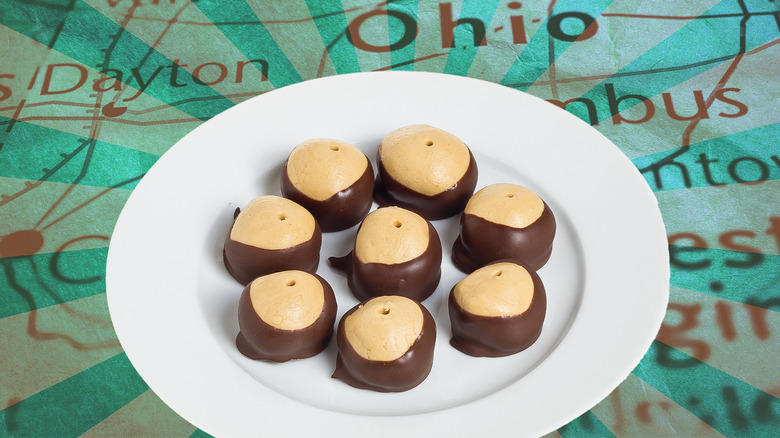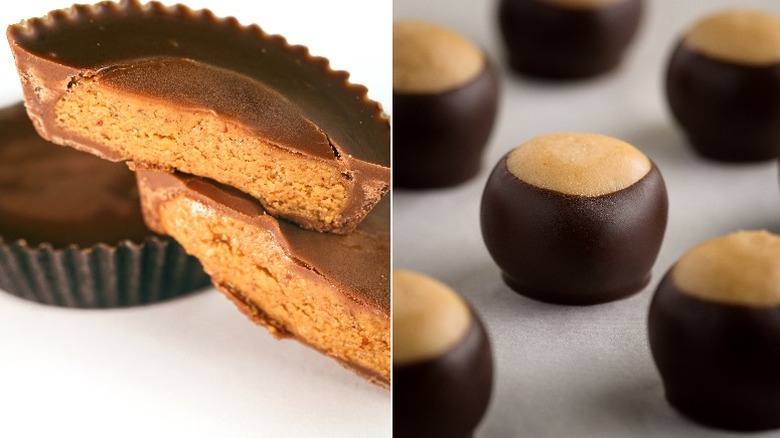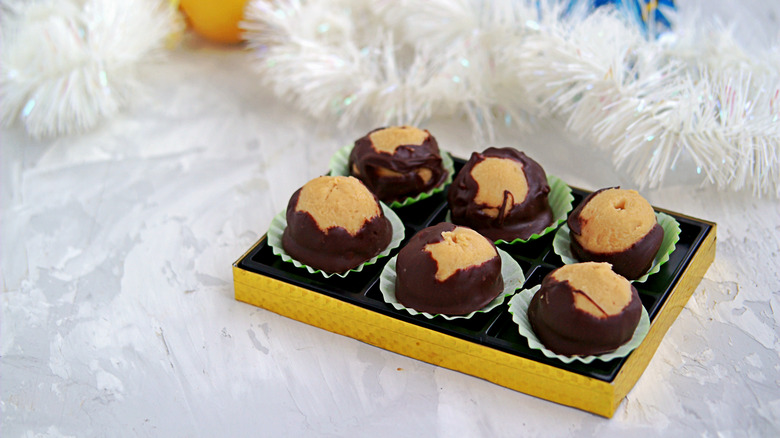How Buckeye Candy Became The Quintessential Treat Of Ohio
Chocolate and peanut butter make for an irresistible treat, but Ohioans will tell you its best version is the buckeye. According to Renee Casteel Cook, author of "Ohio Buckeye Candy: A Sweet History," a tall man named Colonel Ebenezer Sproat opened the first court in Marietta, Ohio, in 1788; because of his height, Native Americans called him "Hetuck," or "the eye of the buck." As nicknames are wont to do, this grew and changed, and by the 1830s, "Buckeye" was a common term for settlers in the Northwest Territory. Six species of buckeye trees are native to the Eastern United States, including the Ohio Buckeye, which is known for its beautiful blossoms and its small, mildly poisonous nuts that are believed to bring good luck.
The legislature voted in the official state tree in 1953, and The Ohio State University adopted the name "Buckeyes" around the same time (after a 20-year soft launch, according to the OSU Lantern). It added a mascot, Brutus the Buckeye, about 15 years later. Journalist Gail Tabor was making her mother's chocolate peanut butter ball recipe when she noticed how much the candy looked like the poisonous nut. She made a batch for her football-loving husband and friends, if they'd swear to keep the recipe a secret — but an acquaintance boldly published the recipe under her own name in The Ohio State Alumni Magazine in 1973. Tabor reclaimed her popular recipe for Buckeye Balls 10 years later, publishing it in Arizona Republic in 1983.
How is a buckeye different from a peanut butter cup?
Gail Tabor, who popularized the Ohio confection, developed her dipped peanut butter buckeyes around Christmas 1963. "A buckeye," she wrote in the Arizona Republic, "for those who need explanation, looks somewhat like a bloated chestnut." Harry Reese developed the peanut butter cup in 1928, and sold his company, H.B. Reese Candy, to Hershey's in 1963, as well. Both candies are often served in a fanned paper cup, and offer a dynamic sensory contrast between peanut butter and chocolate. The buckeye has a higher ratio of peanut butter, and the texture — thanks to powdered sugar — has a particularly satisfying, smooth mouthfeel, like a good icing. Most buckeyes are stored in the freezer or fridge, so the chocolate snaps as you bite into it.
Local ice creams inspired by the treat include Graeters' Buckeye Blitz, Johnsons' Buckeye Fever and PB Chocolate Tornado, and Jenis' Salted Peanut Butter with Chocolate Flecks (formerly The Buckeye State, though the name was changed for national distribution) as well as Buckeye Frenzy. The last of these includes a regional ingredient addition: rice cereal, which is included in the Buckeye recipe around the city of Toledo and the state up north. There's controversy even in the rice crispies! Michigan and Ohio fought over territory from Toledo to the border of Indiana in 1835 and 1836 — arguably setting the groundwork for a heated football rivalry that began in the 1890s and extends to the present day.
How to make buckeyes
To make your own buckeye candies at home, simply combine butter with peanut butter, add salt, vanilla, and powdered sugar, and roll them into balls. Chill in the freezer, then stick a toothpick in each and quickly dip in melted chocolate, leaving a coin-sized bit of peanut butter exposed at the top. Freeze until solid, and pull them out to share at the next Ohio State football game — it's a nonnegotiable part of the spread for The Game (Ohio State versus Michigan).
Another big decision you have to make: Will you leave the toothpick mark in the top before you freeze your peanut butter balls? Some chocolate makers prefer to leave the toothpick mark on the top of their buckeyes to emphasize that each is hand-dipped; others, like Anthony Thomas, aim for a more professional finish. Anthony Thomas covers its buckeyes in white chocolate to cover the toothpick mark and make them shelf-stable — an important trait for a company that sells 12 million buckeyes each year. Ohioans' appetite for buckeyes has sustained the unique recipes of many local businesses, including Wittich's, Honadle's, Winmans, Marie's, Marsha's, Esther Price, and The Buckeye Lady.


